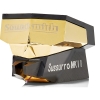How to Tell if Your B&O Cartridge Has Failed
There are two major symptoms of MMC1 MMC2 MMC3 MMC4 or MMC5 cartridge failure, and one for distortion on the MMC10 & MMC20 Series or SP series cartridges.
For the MMC1 through MMC5 ONLY:
PLEASE NOTE:
If there is a loss of one channel on your PHONO only, please see “troubleshooting for a dead channel.” [ADD LINK HERE] If the problem seems to be the B&O cartridge, the link just provided will help you verify if it is the cartridge. If both channels are dead, you cannot use this technique to determine if it is the cartridge or the associated electronics at fault. You must use an OHMMETER, and check each pair of pins at the back end of the cartridge for conductance; opposing pins pairs should read between 700 and 800 ohms, and the pairs should be within 30 ohms of each other.
Causes of Distortion for All Models:
1) Debris on the stylus tip or improper tracking force
One of the most common causes of distortion is a buildup of debris on the stylus tip. The tip must be inspected, and if found to be fouled with debris, should be cleaned off with a stylus brush, and suitable solvent for such purpose. Careful inspection of the stylus tip will reveal severe accumulations of such debris.
Of course, you must verify that you are tracking at the correct force. Too light a tracking force will cause distortion especially during louder passages, and damage your records. Much too high a tracking force will do the same. Please refer to your turntable owner’s manual to learn how to adjust your particular tone arm. Most (but not all B&O tables) suggest verifying the "ZERO" balance of your tone arm, and then setting it for the proper tracking force. The MMC1-5 (or Soundsmith SMMC4,3, and 2) allow you to plug the cartridge in "incorrectly" with the stylus either pointing sideways or up, allowing you to set, or test, both zero balance and tracking force without much risk of damaging the stylus.
2) Failed cartridge
If the tip is clear of debris, and the cartridge sounds very distorted or “grainy,” either the stylus has been broken off, or the suspension for the cantilever (the rod or arm that holds the stylus tip) has failed inside the cartridge body.
To inspect the DIAMOND STYLUS tip in a very casual way, you need a bright light and a strong magnifier glass. The stylus tip (that plays the record) should protrude DOWN from the END of the small “rod” or “cantilever” which extends forward and slightly down from the bottom of the cartridge. That stylus tip should look like the tip of a pointed cone pointing DOWN from the END of the cantilever arm as you look sideways at the cartridge. If it looks flat, the diamond itself has broken off. If it looks like a downward pointing sharp cone, then it may be OK, and you must inspect the cantilever for its position as described below.
The cantilever exits from a small hole in the METAL BODY of the cartridge. It has the black plastic shroud or stylus guard all around it. With a very bright light, and a very good magnifier, note the POSITION of the cantilever as it EXITS the hole in the METAL body of the cartridge. It SHOULD be 2/3 of the way down the hole, and CENTERED left to right. If it is off to one side, or touching the edge of the hole from which it exits, the suspension has failed, and the cartridge must be replaced.
Be careful with the following procedure and note that you can damage the cartridge if it is not done very carefully. If all of the above appears OK, you may also VERY GENTLY deflect the stylus tip upwards. If the cantilever arm SUDDENLY seems to deflect up easily at a certain point in your deflecting it, that also is an indication that the internal suspension has failed. There should be continuous, gentle resistance to moving it upwards a very slight amount, as if it is resting on the record.
Please bear in mind that we can sometime rebuild the original B&O MMC1’s and MMC2’s for a flat fee of $295 only ifthe stylus is not worn or damaged, and they suffer from either channel failure, AND/OR suspensions failure. We can rebuild the complete original MMC1 and MMC2 for any failure for $100 less than our new models. We also can often rebuild the MMC3000 through 6000, as well as MMC10 and 20 series, as well as the SP series of stylus shells for any failure.





